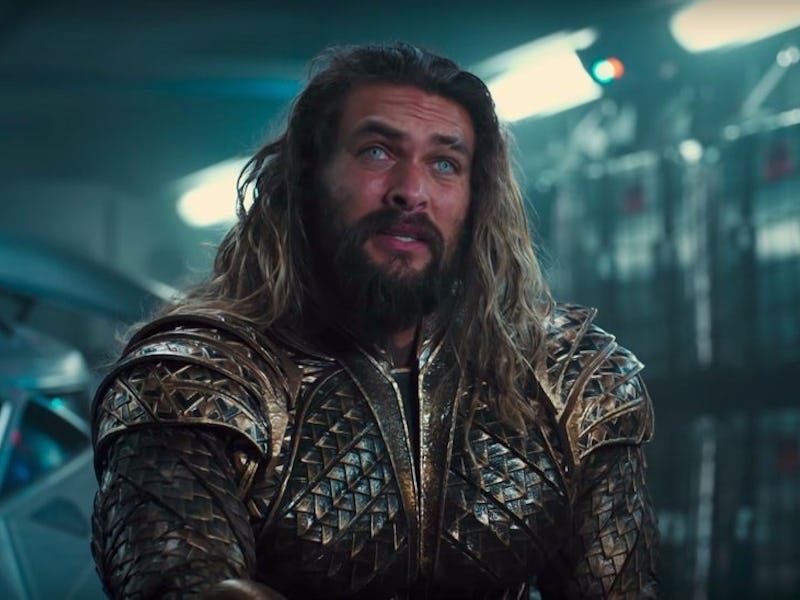You Probably Loved the Single Worst Scene in 'Justice League'
But you should be crying instead of laughing.

There’s plenty of bad to go around in DC’s Justice League between CGI over Henry Cavill’s mustache and the monster-of-the-week bore that was Steppenwolf, but one particular scene that’s played for laughs is downright troubling.
It’s when Aquaman accidentally reveals his inner fears and emotions — and sexually harasses Diana — all because Lasso of Truth is wrapped around his right ass cheek.
Everyone in your theater probably laughed, including you, without realizing that this one scene captures all of the film’s primary faults: The plotting of the moment is illogical, the thematic value is vocalized rather than dramatized, and the script objectifies Wonder Woman needlessly. Honestly, it’s almost impressive the writing can juggle all this in one scene, distilling everything wrong with Justice League into one hollow punchline.
We’re appropriately startled by Aquaman’s outburst, mostly because it undermines the swashbuckling machismo we’ve come to love throughout Justice League. But when he shifts in his seat to reveal that the Lasso of Truth was behind it all, every audience member laughs on cue.
But why? The scene is actually pretty terrible for the following reasons.
So where exactly is the Lasso?
There’s Nothing Logical or Practical About the Scene
For some reason, Aquaman is just sitting on top of the Batmobile hanging out while the rest of the team runs through the plans.
Inexplicably, the Lasso was around some part of his body offscreen. We see him pull it from what sort of looks like under his right leg.
For the Lasso to work, it has to be around some part of a person’s body, right? So what actual part of Aquaman is it around here? Based on the full shot of him featured above, it must be his ass cheek, right? Where else could it be?
But also, why would Wonder Woman just leave her Lasso hanging around like that? Why wouldn’t Aquaman see a shining golden rope right on the place he decided to sit? The moment is contrived for the sake of the punchline without recognizing that it makes no sense at all — a bit like most of Justice League’s plot.
There's a lot of talking in this movie.
The “Point” Is Vocalized Rather Than Dramatized
Another huge problem with Justice League that’s made brazenly clear during Aquaman’s confession is summed up by the classic lesson in filmmaking of “show vs. tell.” You manufacture drama by showing how and why a character cares about something rather than having them tell someone else within the movie. Viewers crave drama, not a bunch of talking heads.
It’s a lazy copout to fabricate Aquaman’s confession in this way. In fact, perhaps the best scenes we get from Jason Momoa as Aquaman are earlier in the film that present his inner conflict in a legitimate dramatic way: he rejects Bruce Wayne’s call to arms yet still risks his own life to save a fisherman and yet again to protect Atlantis. We don’t need Aquaman to tell us he never fully embraced the sea or the land, because we’ve already seen his uncertainty play out in dramatic fashion.
So much of why the DCEU fails with its storytelling is because its characters talk too much, Aquaman included. Bruce Wayne says that he’d gladly trade his life for Superman’s, but wouldn’t it be so much better to see him at least try do it rather than talk about it? And how often do we see huge black flags with the Superman symbol on them or headlines about his death rather than people genuinely distraught over the death?
A story needs to earn its plot beats, not vocalize them in overly simple ways.
'Justice League' was made for the male gaze.
The Justice League’s Female Hero Gets Unnecessarily Objectified
Aquaman spends a portion of his brief monologue complaining about the Flash tripping all the time, Batman’s lack of powers, and the fact that Cyborg might be an unintentional spy. But when he gets to Diana, the “fault” he finds with her is troubling to say the least. He pauses and says, “Woof, you’re gorgeous, and fierce, and strong and mmf!! — I know we went to war with the Amazons, but that was before my time.” Of course, everyone knows what he’s thinking when he goes mmf!.
Gross.
Justice League also has its fair share of gratuitous shots that prominent feature Diana’s butt in the foreground while innocuous things like elevator rides happen in the background. Wonder Woman is a shadow of the glorious hero she was in her solo film, which makes it horrifying to hear Aquaman grovel in her direction in such a gross, lusty way.
Yet, as he does this, the camera cuts to Batman and Wonder Woman, and each smirks as if they’re on the inside of some joke. Not only is it bad writing, but it’s also bad directing, because neither the script nor direction — whether this scene gets it from Joss Whedon or Zack Snyder — recognizes the problematic nature of what’s going on.
Why does DC’s best hero get reduced to a victim in this fashion?
It’s pretty easy to laugh at the Aquaman confession as it happens, but maybe we should all be crying a little bit, instead.